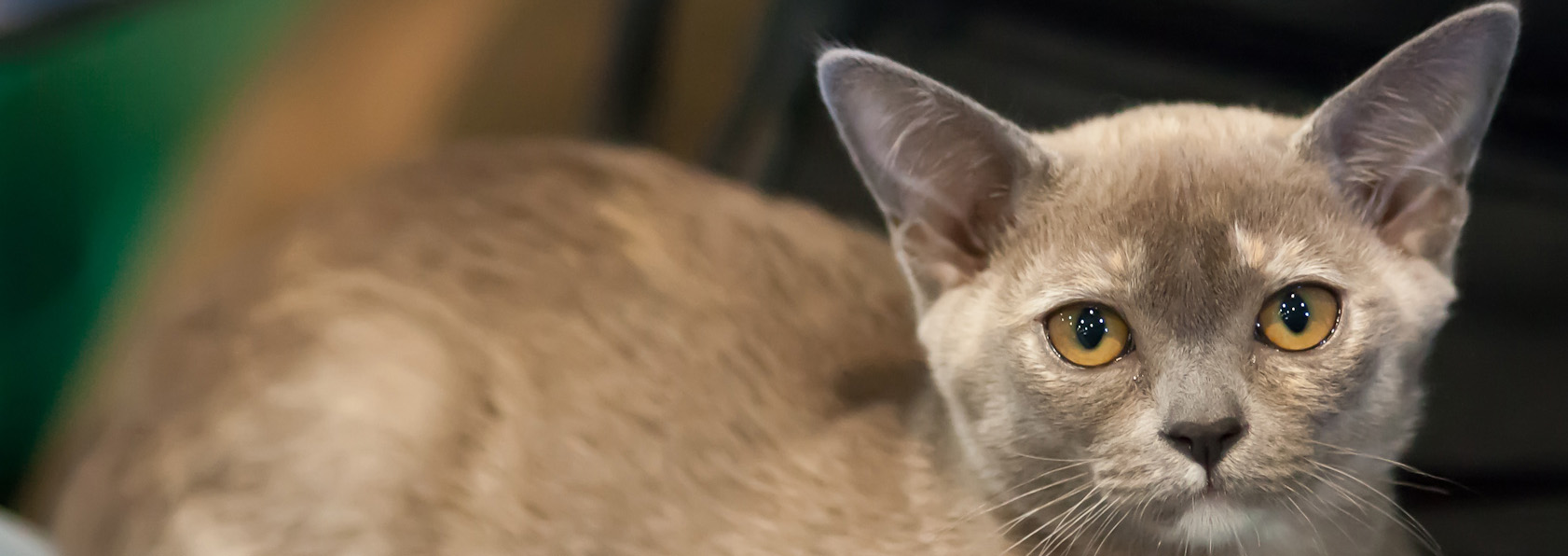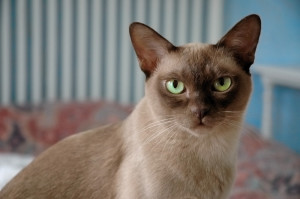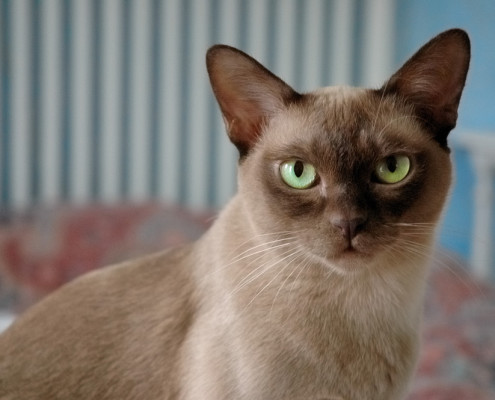Burmese

Meoww!!
Burmese carefully observe household activities and seem to posses a “monkey see, monkey do” attitude. That explains why they are masters at opening cabinets and stashing your favorite pair of earrings or car keys in their favorite hiding spots.
In 5 Words
- Intelligent
- Energetic
- Adaptable
- Friendly
- Playful
Snapshot
Size: small to medium
Weight:
8 – 10 pounds | male
6 – 8 pounds | female
Origin: India
Life Span: 12 -16 years.
Colour: Sable (a coffee brown color) and followed by champagne, blue and platinum
Litter Size:

Characteristics
Learn About the Burmese
Burmese cats lived for centuries in Burma, Thailand and Malaya. In late 1800s they were known in England as Chocolate Siamese, but because they were not favoured they gradually died out in England and Europe. The ancestry of Burmese cats can be traced back to one cat named Wong Mau, who was a brown female from Burma and arrived to San Francisco in the early 1930′s to Dr. Joseph Thompson.
Through selective breeding to Siamese, the Burmese was established as a distinct breed. Lighter coloured kittens were occasionally produced and eventually the American breeders requested cognition from CFA for these “dilute” colours; first, as another breed named Malayan, then later as a dilute division of Burmese.
Burmese carry surprising weight for their size and have often been described as “bricks wrapped in silk.” Their coats are very short, satin-like in texture, and generally require little grooming other than daily petting. There is a range in Burmese head and body type; the more compact cats with the rounder heads are seen in the show ring. Burmese have large, expressive eyes that are great pools of innocence and seductive appeal, irresistible in effect. These eyes are their most persuasive weapon in an arsenal of endearing traits that mask an awesome power to hypnotize their owners into life-time love affairs through which they effortlessly rule their families.
Breeders and fanciers report that Burmese are amusing, playful, and super-smart, the perfect interactive cats for home, office, shop, any place where people are in need of love and entertainment. They are as active as the Siamese and love to play. Devoted cats, Burmese are loyal and people-oriented.
Breeders report temperament differences between males and females. The females are highly curious, active, and very emotionally involved with their family. The altered males love their humans too, but are more placid. They like to lounge about, usually on top of whatever you’re doing. They take life as it comes. The only issue about which they are passionately concerned is the selected cuisine and when it will be served.
Burmese have a unique rasp to their voices and sound a bit like cats going hoarse from too much talking. Burmese are not as talkative as their Siamese neighbors. When they have something to say, however, they’ll reiterate the message until you get out your universal feline/human translator and take care of whatever it is troubling them.
Burmese are generally very healthy cats, although there are a couple of rarely seen conditions that can affect a very small number UK Burmese lines. The first is an acute teething discomfort suffered by some young kittens whilst the second set of teeth is coming through, with a more extreme reaction than is seen in other breeds. As soon as the second teeth break through, the problem is alleviated although it is distressing for kitten and owner if it does occur, as there is no veterinary treatment that will help. The other known condition is Hypokalemia, where the blood levels of potassium are low, and which can affect kittens of around 6 months in very rare cases, although with prompt treatment the kitten may well make a full recovery. However, it is a very rare recessive gene traceable to certain breeding lines, and both parents must carry the gene for the kittens to develop the problem. As always, it is very important to purchase a kitten from a reputable breeder who will not have cross-bred particular lines. In common with all breeds of cat, Burmese need annual vaccination boosters against the common feline ailments of flu and enteritis, as well as against Feline Leukaemia if they go outdoors. It is wise to have Burmese kittens neutered by the age of 6 months, as, like the Siamese, they tend to mature sexually at a very young age.
Burmese will eat most good quality proprietary brands of cat food, but will also enjoy treats of cooked chicken, ham and grated cheese. However, cows’ milk will probably give them a stomach upset, and a bowl of water should always be available. Eyes and ears should be checked and kept clean if necessary by use of a clean damp cloth. These cats have very short glossy coats, which need little grooming, and can normally be kept free of loose hairs simply by stroking. Burmese can live very happily indoors without going outside, so long as they have a scratching post to and plenty of toys to occupy them.






